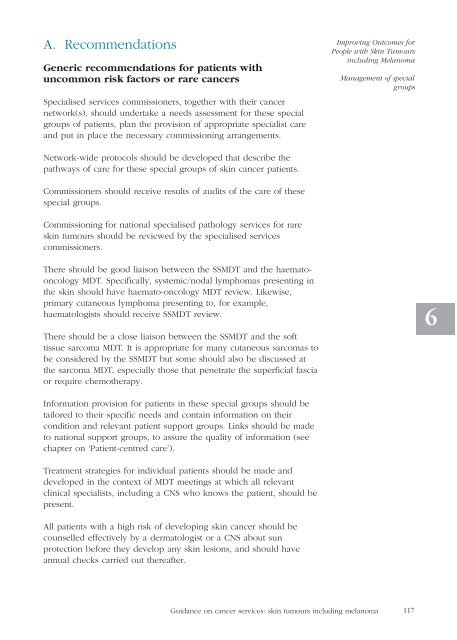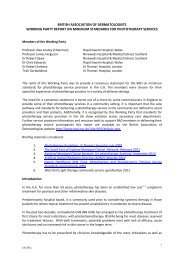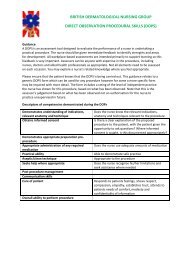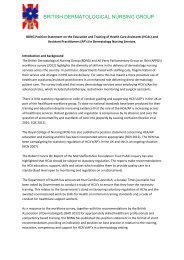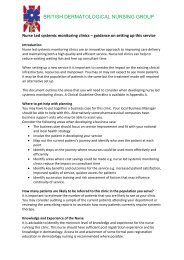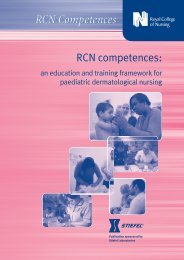Improving outcomes for people with skin tumours including melanoma
Improving outcomes for people with skin tumours including melanoma
Improving outcomes for people with skin tumours including melanoma
Create successful ePaper yourself
Turn your PDF publications into a flip-book with our unique Google optimized e-Paper software.
A. Recommendations<br />
Generic recommendations <strong>for</strong> patients <strong>with</strong><br />
uncommon risk factors or rare cancers<br />
Specialised services commissioners, together <strong>with</strong> their cancer<br />
network(s), should undertake a needs assessment <strong>for</strong> these special<br />
groups of patients, plan the provision of appropriate specialist care<br />
and put in place the necessary commissioning arrangements.<br />
<strong>Improving</strong> Outcomes <strong>for</strong><br />
People <strong>with</strong> Skin Tumours<br />
<strong>including</strong> Melanoma<br />
Management of special<br />
groups<br />
Network-wide protocols should be developed that describe the<br />
pathways of care <strong>for</strong> these special groups of <strong>skin</strong> cancer patients.<br />
Commissioners should receive results of audits of the care of these<br />
special groups.<br />
Commissioning <strong>for</strong> national specialised pathology services <strong>for</strong> rare<br />
<strong>skin</strong> <strong>tumours</strong> should be reviewed by the specialised services<br />
commissioners.<br />
There should be good liaison between the SSMDT and the haematooncology<br />
MDT. Specifically, systemic/nodal lymphomas presenting in<br />
the <strong>skin</strong> should have haemato-oncology MDT review. Likewise,<br />
primary cutaneous lymphoma presenting to, <strong>for</strong> example,<br />
haematologists should receive SSMDT review.<br />
There should be a close liaison between the SSMDT and the soft<br />
tissue sarcoma MDT. It is appropriate <strong>for</strong> many cutaneous sarcomas to<br />
be considered by the SSMDT but some should also be discussed at<br />
the sarcoma MDT, especially those that penetrate the superficial fascia<br />
or require chemotherapy.<br />
6<br />
In<strong>for</strong>mation provision <strong>for</strong> patients in these special groups should be<br />
tailored to their specific needs and contain in<strong>for</strong>mation on their<br />
condition and relevant patient support groups. Links should be made<br />
to national support groups, to assure the quality of in<strong>for</strong>mation (see<br />
chapter on ‘Patient-centred care’).<br />
Treatment strategies <strong>for</strong> individual patients should be made and<br />
developed in the context of MDT meetings at which all relevant<br />
clinical specialists, <strong>including</strong> a CNS who knows the patient, should be<br />
present.<br />
All patients <strong>with</strong> a high risk of developing <strong>skin</strong> cancer should be<br />
counselled effectively by a dermatologist or a CNS about sun<br />
protection be<strong>for</strong>e they develop any <strong>skin</strong> lesions, and should have<br />
annual checks carried out thereafter.<br />
Guidance on cancer services: <strong>skin</strong> <strong>tumours</strong> <strong>including</strong> <strong>melanoma</strong><br />
117


